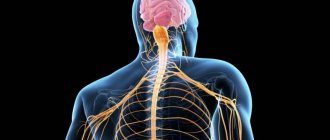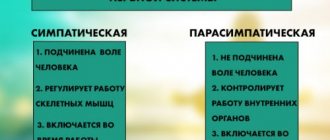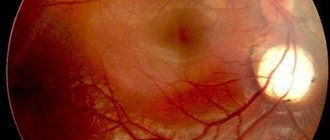The mediator acetylcholine: why do humans and other living beings need it? How are acetylcholine and nicotine related? Where is acetylcholine produced and how does it work?
Acetylcholine is one of the main neurotransmitters in the nervous system. But there is very little information about the mediator acetylcholine, written in understandable language. Wikipedia and other sources talk about neurotransmitters with many complex terms that are difficult to understand the first time. In this article we will try to talk about acetylcholine in simple and understandable language.
What are neurotransmitters anyway? Neurotransmitters are chemicals that carry information in the human nervous system. That is, information between nerve structures, in this case, is transmitted not using an electrical impulse, but precisely thanks to special molecules that float in the intercellular fluid. These molecules are called mediators.
We need to immediately tell you about the most important properties of acetylcholine for humans. It directly affects memory and academic performance. The higher the acetylcholine level, the higher they are. And the second important function of the mediator is the process of falling asleep. We fall asleep when we have very little acetylcholine. If you can't sleep, you probably have high acetylcholine levels. This may be due to the fact that you moved a lot or worked at all. We'll tell you why below.
Acetylcholine molecule
Discovery of the neurotransmitter acetylcholine
Acetylcholine was the first neurotransmitter discovered by scientists. And this was done by the German pharmacologist Otto Lewy. In his amazing experiment, acetylcholine stopped a frog's heart.
- Experiment with the neurotransmitter acetylcholine and frog hearts
The scientist took two frog hearts and immersed them in saline solution. And the peculiarity of the frog’s heart is that they can beat for a very long time in a special physiological solution. Then he began to irritate the vagus nerve, which came out of one of the hearts, with an electric current. The heart slowed down its rhythm (this is how it should happen).
After this, the scientist collected some liquid near the heart into a syringe and poured this liquid into the vessel where the second heart was beating. The second heart also slowed down its rhythm.
Otto Lewy's experiment
For the discovery of acetylcholine, and with it neurotransmitters in general, Levy was awarded the Nobel Prize. They say that he dreamed about the experience with frogs at night. Moreover, the dream was repeated twice; the first time the scientist did not understand what he was dreaming about.
Acetylcholine and nicotine
The neurotransmitter acetylcholine is important in the sense that it is its molecule that nicotine copies. In general, almost all drugs are similar in molecular structure to different neurotransmitters.
- Nicotine replaces acetylcholine.
- Opium and heroin copy another neurotransmitter - dopamine, which is also called the “happiness hormone”.
- Ecstasy replaces serotonin, one of the pleasure hormones.
- Alcohol does not replace any mediator with its molecule, but its effect on metabolic processes in the brain is very strong. Alcohol increases dopamine levels, although not as much as opium. Alcohol also complicates the functioning of GABA, a neurotransmitter that is responsible for calmness, concentration and learning. That is, alcohol “turns off the brain” and affects two systems of mediators at once.
There is a drug that blocks cravings for nicotine - Tabex with the active substance cytisine. There is also a more modern drug, Champix, with the active ingredient varenicline. The molecules of these substances connect to acetylcholine receptors in those places where acetylcholine is attached in healthy people or nicotine in smokers. As a result, the craving for nicotine disappears. However, medications are not necessary for those who want to quit smoking; the human body has everything to cope with this problem on its own.
In addition to smoking, there is also chewing, snuff and even sucking tobacco. Nicotine can be absorbed through the skin. This is the basis of the action of nicotine patches. There is also nicotine spray and chewing gum.
The acetylcholine molecule is copied not only by nicotine from tobacco. For example, agonist substances or “substitutes” for acetylcholine are also found in belladonna and dope. The effect of these plants on the human body is even more destructive than that of tobacco.
Datura can cause hallucinations, tachycardia, and photophobia.
But any poison in small dosages becomes a medicine, and preparations from dope and belladonna are used to relieve pain, spasms, to test vision and for some other purposes. For example, the main purpose of the drug Bellastesin is pain relief for stomach ulcers. But you should still be extremely careful with such medications and try to avoid them. In addition to many side effects, they cause persistent addiction.
A drug that duplicates acetylcholine
In general, nicotine and similar substances in plants are toxins. Plants use them as a nerve poison against beetles and other pests that want to feast on them. Nicotine acts like a deadly poison on insects; they are smaller and more vulnerable than humans. Even ripe tomatoes contain small amounts of nicotine; there is a little more of it in tomato leaves and potato leaves. To prevent insects from attacking your garden plants, you can use powdered tobacco. It is also used as a fertilizer.
How to increase the level of the neurotransmitter acetylcholine in the body?
There are three main ways to increase levels of the neurotransmitter acetylcholine in the body:
- nutrition;
- regular physical activity;
- intellectual training.
Foods rich in choline (vitamin B4) - liver (chicken, beef, etc.), eggs, milk and dairy products, turkey, green leafy vegetables. It is better to replace coffee with tea.
When there is a shortage of raw materials for the production of the neurotransmitter acetylcholine, the brain begins to “eat itself,” so carefully monitor your diet.
THIS IS A DESCRIPTION OF THE CHARACTER OF AN “UNHAPPY” PERSON
Its 2 main problems:
1) chronic unsatisfaction of needs,
2) the inability to direct his anger outward, holding it back, and with it holding back all warm feelings, makes him more and more desperate every year: no matter what he does, it doesn’t get better, on the contrary, it only gets worse. The reason is that he does a lot, but not that.
If nothing is done, then, over time, either the person will “burn out at work,” loading himself more and more until he is completely exhausted; or his own self will be emptied and impoverished, unbearable self-hatred will appear, a refusal to take care of oneself, and in the future, even self-hygiene.
A person becomes like a house from which the bailiffs have removed the furniture.
Against the background of hopelessness, despair and exhaustion, there is no strength or energy even for thinking.
Complete loss of the ability to love. He wants to live, but he begins to die: sleep and metabolism are disturbed...
It is difficult to understand what he lacks precisely because we are not talking about the deprivation of possession of someone or something. On the contrary, he has the possession of deprivation, and he is not able to understand what he is deprived of. His own self turns out to be lost. He feels unbearably painful and empty: and he cannot even put it into words.
If you recognize yourself in the description and want to change something, you urgently need to learn two things:
1. Learn the following text by heart and repeat it all the time until you learn to use the results of these new beliefs:
- I have a right to needs. I am, and I am I.
- I have the right to need and satisfy needs.
- I have the right to ask for satisfaction, the right to achieve what I need.
- I have the right to crave love and love others.
- I have the right to a decent organization of life.
- I have the right to express dissatisfaction.
- I have the right to regret and sympathy.
- ...by right of birth.
- I may get rejected. I may be alone.
- I'll take care of myself anyway.
I would like to draw the attention of my readers to the fact that the task of “learning a text” is not an end in itself. Autotraining by itself will not give any lasting results.
It is important to live, feel, and find confirmation of it in life. It is important that a person wants to believe that the world can be arranged somehow differently, and not just the way he is used to imagining it.
That how he lives this life depends on himself, on his ideas about the world and about himself in this world. And these phrases are just a reason for thought, reflection and search for your own, new “truths”.
2. Learn to direct aggression towards the person to whom it is actually addressed.
...then it will be possible to experience and express warm feelings to people. Realize that anger is not destructive and can be expressed.
DO YOU WANT TO FIND OUT WHAT A PERSON MISSS TO BECOME HAPPY?
BEHIND EVERY “NEGATIVE EMOTION” LIES A NEED OR DESIRE, THE SATISFACTION OF WHICH IS THE KEY TO CHANGES IN LIFE...
YOU CAN SIGN UP FOR A CONSULTATION USING THIS LINK:
Psychosomatic diseases (it will be more correct) are those disorders in our body that are based on psychological causes. psychological reasons are our reactions to traumatic (difficult) life events, our thoughts, feelings, emotions that do not find timely, correct expression for a particular person.
Mental defenses are triggered, we forget about this event after a while, and sometimes instantly, but the body and the unconscious part of the psyche remember everything and send us signals in the form of disorders and diseases
Sometimes the call may be to respond to some events from the past, to bring “buried” feelings out, or the symptom simply symbolizes what we forbid ourselves.
YOU CAN SIGN UP FOR A CONSULTATION USING THIS LINK:
The negative impact of stress on the human body, and especially distress, is colossal. Stress and the likelihood of developing diseases are closely related. Suffice it to say that stress can reduce immunity by approximately 70%. Obviously, such a decrease in immunity can result in anything. And it’s also good if it’s just colds, but what if it’s cancer or asthma, the treatment of which is already extremely difficult?
Where is acetylcholine produced?
Acetylcholine is produced at neuromuscular junctions near the spine. And it is produced in response to movement, in response to stress, and in general almost constantly. That is, if you decide to move your finger, then signals pass through your nerve fibers. For example, the signal passed from the finger to the spine (the axons or processes of nerve cells are sometimes really so long). In response, a nerve synapse near your spine released the neurotransmitter acetylcholine, which caused your finger to bend.
Many conclusions can be drawn from this simple description:
- The simplest conclusion is that active movements and work increase acetylcholine levels and make it difficult to fall asleep.
- Another conclusion is that acetylcholine mobilizes the body. Therefore, if you need to do important work, even mental work, then physical activity will help you.
- Interestingly, acetylcholine is produced not only when you consciously decide to move, but also in nervous and restless individuals. The more anxious a person is, the higher their acetylcholine levels.
- If you decide to quit smoking, then playing sports will make your quitting process faster, but more noticeable. What we don’t use atrophies. And a smoker produces little acetylcholine. If you move a lot, you will put a lot of stress on this system.
Creation and destruction of acetylcholine
Pros of acetylcholine:
— Improves the cognitive abilities of the brain, makes you smarter.
— Improves memory, helps in old age.
— Improves neuromuscular connection. Useful in sports, due to faster adaptation of the body to stress. It will indirectly force you to lift more weight or run a distance faster, through rapid adaptation to existing conditions.
— Acetylcholine is not stimulated by any drugs, but rather is suppressed, there is no reason for abuse. Acetylcholine is most suppressed by hallucinogens. This is logical; for delirium to occur, you need a dull brain.
- Overall, a useful neurotransmitter for everyday calm life. Helps you plan, reduce impulsive decisions and mistakes. Corresponds to the proverb “Measure twice, cut once.”
Life cycle of acetylcholine
Let's explain some terms in the previous diagram:
Choline acetylase is an enzyme that catalyzes, that is, accelerates and enhances the reaction of the formation of acetylcholine. It is created from two substances acetic acid and choline. Scientists have not yet been able to isolate choline acetylase in its pure form. Its quantity can be judged by indirect signs: the amount of acetylcholine and the rate of its accumulation.
Vitamin B1 , also called thiamine, plays a very important role in the production of choliacetylase . Thiamine, as a medicine, is indicated for use in case of its deficiency, sometimes during pregnancy, heart failure, severe liver disease and other disorders. Thiamine supports processes associated with the functioning of insulin and stimulates the production of the mediator acetylcholine.
Thiamine is available in the form of an injection solution and in tablet form in combination with other B vitamins. These vitamins are indicated for neurological disorders, physical damage to nerve tissue, alcoholism, chemical poisoning and some other conditions.
Thiamine preparation
M and N cholinergic receptors. Receptors are structures that catch a certain substance, in our case the neurotransmitter acetylcholine. It often happens that there is only one mediator, but there are several receptors on which it affects. Acetylcholine acts on nicotinic and muscarinic receptors.
- Nicotinic receptors are found in skeletal muscles and in the autonomic ganglia. The agonist, that is, the substance that replaces acetylcholine in them, is nicotine. These receptors are completely blocked by the deadly snake venom curarine.
- Muscarinic receptors can be found in large numbers in smooth muscle and in the brain. Muscarine, the poison of fly agarics, henbane and other nightshade plants, can replace acetylcholine in them. And poisonous atropine blocks these receptors.
Acetylcholine[edit | edit code]
Source:
Clinical Pharmacology by Goodman and Gilman Volume 1
.
Editor
: Professor A.G.
Gilman Ed.
: Practice, 2006.
Acetylcholine
(lat. Acetylcholinum) - a mediator of the nervous system, a biogenic amine related to substances formed in the body.
Acetylcholine plays an important role as a mediator of the central nervous system. It is involved in the transmission of impulses in different parts of the brain, with small concentrations facilitating and large concentrations inhibiting synaptic transmission. Changes in acetylcholine metabolism can lead to impaired brain function.
Acetylcholine is a mediator of nerve impulse transmission to the muscle. With a lack of acetylcholine, the strength of muscle contractions decreases.
The endings of the nerve fibers for which it serves as a mediator are called cholinergic, and the receptors that interact with it are called cholinergic receptors. Cholinergic receptors of postganglionic cholinergic nerves (heart, smooth muscles, glands) are designated as m-cholinergic receptors (muscarine-sensitive), and those located in the area of ganglionic synapses and in somatic neuromuscular synapses are designated as n-cholinergic receptors (nicotine-sensitive). This division is associated with the characteristics of the reactions that occur during the interaction of acetylcholine with these biochemical systems: muscarinic-like in the first case and nicotine-like in the second; m- and n-cholinergic receptors are also located in different parts of the central nervous system.
Storage and release of acetylcholine[edit | edit code]
When microelectrode recording of electrical potentials of the postsynaptic membrane of the neuromuscular synapse, Fatt and Katz (1952) identified spontaneous small (0.1-3 mV) depolarizing potentials that occurred randomly approximately once per second. The authors called these potentials miniature endplate potentials. Their amplitude was significantly below the threshold for the development of an action potential. They increased under the influence of the AChE inhibitor neostigmine and were blocked by tubocurarine (a competitive blocker of N-cholinergic receptors); therefore, they were due to the release of acetylcholine. In this regard, it was suggested that acetylcholine is released from presynaptic endings in fractional constant portions - quanta. The morphological substrate of quanta, synaptic vesicles, was soon discovered (De Robertis and Bennett, 1955). When an action potential arrives at the axon terminal of a motor neuron, 100 or more quanta (vesicles) of acetylcholine are released (Katz and Miledi, 1965). The patterns of acetylcholine storage and release studied at the neuromuscular junction are also applicable to other cholinergic synapses with fast transmission.
It is estimated that each vesicle contains from 1000 to 50,000 molecules of acetylcholine, and the presynaptic terminal of a motor neuron contains 300,000 or more vesicles. In addition, it is possible that a fairly significant amount of acetylcholine is diffusely dissolved in the axoplasm. Recording of currents of single channels of the postsynaptic membrane of the neuromuscular synapse with constant application of acetylcholine showed that one molecule of this mediator causes a potential of the order of 3 x 10”7 V. It follows from this that even the minimum (according to calculations) amount of acetylcholine in one vesicle is 1000 molecules — is sufficient to induce a miniature endplate potential (Katz and Miledi, 1972).
Exocytosis of acetylcholine and other mediators from presynaptic terminals is suppressed by botulinum toxin and tetanus toxin - poisons of Clostridium botulinum and Clostridium tetani, respectively. These anaerobic spore-forming organisms produce some of the most potent toxins known (Shapiro et al., 1998). Clostridium toxins, consisting of heavy and light chains linked by disulfide bridges, bind to an as yet unknown receptor at the cholinergic terminal and are then transported through endocytosis into the cytosol. The light chain is a zinc-containing endopeptidase that, upon activation, hydrolyzes core components of the SNARE complex involved in exocytosis. Different types of botulinum toxin destroy different proteins of the presynaptic membrane (syntaxin-1 and SNAP-25) and synaptic vesicles (synaptobrevin). Botulinum toxin A as a drug is discussed in Chapter. 9 and 66.
Tetanus toxin is a poison of central action: it is retrogradely transported along the axons of motor neurons into the bodies of these neurons in the spinal cord, then passes into the inhibitory neurons associated with motor neurons and blocks the exocytosis of the transmitter from the latter. This is what leads to the cramps characteristic of tetanus. The venom of the black widow spider, α-latrotoxin, binds to transmembrane proteins of presynaptic terminals called neurexins, causing massive exocytosis of synaptic vesicles (Schiavo et al., 2000).
Acetylcholine and emotional balance
Smokers know that they need a cigarette to calm down, to cheer up in the morning. Nicotine helps them think about complex problems and, on the contrary, begin active physical work, which does not require much thinking. plays the same role in the human body .
Interestingly, in addition to chemicals, genes also influence the production of acetylcholine. Someone got enzymes and synapses that provide them with a large amount of acetylcholine. And some people have relatively little of this neurotransmitter. Skewing in one direction or the other is not very good.
- With an excess of acetylcholine, a person has excellent memory and a lively mind. But at the same time, he cannot calm down quickly; he is tormented by insomnia.
- With a lack of acetylcholine, a person is calmer and more restrained. But it may seem that he lacks mental agility and speed of reaction.
Acetylcholine levels depend not only on genes. Lifestyle plays a role. Especially physical activity. Psychological attitudes, especially anxiety and severe stress, also play an important role.
Acetylcholine performs the same role as motor oil in an engine
Physiological properties
In small doses, acetylcholine is a physiological transmitter of nervous excitation, and in large doses it can block the transmission of excitation.
This neurotransmitter is affected by smoking and consumption of fly agarics.
Connection with dopamine
Dopamine is one of the internal reinforcement factors (IRFs) that is released when experiencing pleasure. It has narcotic analogues: amphetamine, ecstasy, ephedrine. Cocaine is a dopamine reuptake inhibitor (makes more dopamine available). Reserpine blocks the pumping of dopamine into presynaptic vesicles.
Various substances play a mediator role: norepinephrine, dopamine, acetylcholine, serotonin, g-aminobutyric acid, glycine , etc.
Some - acetylcholine, norepinephrine, dopamine, serotonin - are involved in the transmission of excitation in synapses, others - g-aminobutyric acid, glycine, adenosine - inhibit interneuron transmission.
The main neurotransmitters for the peripheral nervous system are norepinephrine and acetylcholine .
Women have more dopamine, and men acetylcholine , so they are more prone to certain diseases such as heart attack and ulcers. Children also have a lot of dopamine, which may be why they are happier.
The connection between acetylcholine and dopamine is that they are antagonists for each other. Dopamine excites, acetylcholine inhibits.
Acetylcholine dopamine and Parkinson's disease
The mediator acetylcholine is difficult to consider without its connections with other mediators. An example of the improper interaction between acetylcholine and dopamine is the symptoms of Parkinson's disease.
Parkinson's disease is a currently incurable disease that occurs primarily in old age. Although early parkinsonism also occurs from the age of 30. A characteristic feature of such patients is constant trembling of the limbs and difficulties in coordinating movements. Even sitting on a chair or climbing stairs is a problem for such people.
The cause of Parkinson's disease is the depletion and death of cells in the brain that produce the neurotransmitter dopamine. As a result, great difficulty arises in sending a conscious impulse to the muscles, and control over the body is weakened. But the activity of the mediator acetylcholine remains the same. The result is the trembling characteristic of Parkinson's disease.
They try to smooth out this condition using various methods: by blocking the synthesis of acetylcholine or artificially increasing the level of dopamine. But all these drugs are serious and have many side effects. For example, the activity of acetylcholine is reduced by cyclodol, and dopamine is increased by levadopa.
In Alzheimer's disease, which also occurs in old people, acetylcholine, on the contrary, is not enough. And drugs that increase acetylcholine are used for them. These drugs help fight dementia and memory loss in the elderly.
Parkinson's disease
What is acetylcholine
Nootropics, also known as mental stimulants, have become popular in recent years. Acetyl choline is a neurotransmitter that is involved in brain functions such as memory, thought process and learning.
Acetylcholinum
There are no dietary supplements containing acetylcholine, but supplements that increase acetylcholine levels indirectly are becoming increasingly popular. Acetylcholine imbalance is associated with several diseases. People with Alzheimer's and Parkinson's diseases have low levels of acetylcholine.
Mediator acetylcholine and VSD
The diseases that we wrote about above, parkinsonism and Alzheimer's disease, are poorly understood and require further research. Another mysterious disease that, in our opinion, is associated with the mediator acetylcholine is VSD or vegetative-vascular dystonia.
the diagnosis of VSD very often. According to various sources, this disorder affects from 25 to 70 percent of people. VSD occurs especially often during hormonal changes in adolescents or in women during menopause.
There is an opinion that VSD is a disease that occurs due to the fact that a person’s “needs” and “wants” do not coincide. For example, you are traveling on a trolleybus and are very tired. You relax in the seat and almost fall asleep, but the next second you remember that people are looking at you and force yourself to wake up. This is repeated several times. The balance of neurotransmitters and vascular tone changes. It's tiring. As a result, hypertension may occur or, on the contrary, blood pressure may drop.
Acetylcholine is an important part of the autonomic system. According to the results of recent Russian studies, stress (which is considered the main cause of VSD) causes the release of large amounts of acetylcholine. Acetylcholine is considered a resting neurotransmitter, but after extreme arousal or stress, much more of it is released than usual. If the compensatory systems do not cope and some kind of imbalance occurs in the autonomic system, then this leads to the well-known symptoms of VSD. However, there are now more questions than answers regarding the acetylcholine mediator and the connections between the autonomic and nervous systems.
You may be interested in other articles on our website about hormones and neurotransmitters:
- What is dopamine?
- 5 hormones of joy, happiness and pleasure.
- High and low estrogen in women.
- Oxytocin is the hormone of attachment and pregnancy.
- Adrenaline mediator and medical drug.
Application
General Application
Acetylcholine chloride (lat. Acetylcholini chloridum)
). Acetylcholine chloride is not widely used as a medicine.
Treatment
When taken orally, acetylcholine is ineffective because it is quickly hydrolyzed. When administered parenterally, it has a quick, sharp, but short-lived effect. Like other quaternary compounds, acetylcholine penetrates the blood-brain barrier poorly and does not have a significant effect on the central nervous system. Sometimes acetylcholine is used as a vasodilator for spasms of peripheral vessels (endarteritis, intermittent claudication, trophic disorders in the stumps, etc.), and for spasms of the retinal arteries. In rare cases, acetylcholine is administered for intestinal and bladder atony. Acetylcholine is also sometimes used to facilitate x-ray diagnosis of esophageal achalasia.
Form of application
The drug is prescribed subcutaneously and intramuscularly in a dose (for adults) of 0.05 g or 0.1 g. Injections, if necessary, can be repeated 2-3 times a day. When injecting, make sure that the needle does not enter a vein. Intravenous administration is not allowed due to the possibility of a sharp decrease in blood pressure and cardiac arrest.
Higher doses
subcutaneously and intramuscularly for adults:
- single dose 0.1 g,
- daily 0.3 g.
When using acetylcholine, it should be taken into account that it causes a narrowing of the coronary vessels of the heart. In case of an overdose, a sharp decrease in blood pressure with bradycardia and heart rhythm disturbances, profuse sweat, miosis, increased intestinal motility and other phenomena may be observed. In these cases, 1 ml of a 0.1% solution of atropine (repeatedly if necessary) or another anticholinergic drug should be immediately injected into a vein or under the skin (see Metacin).










